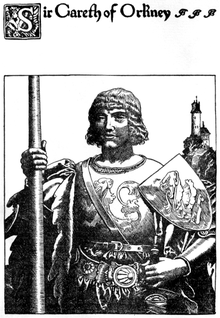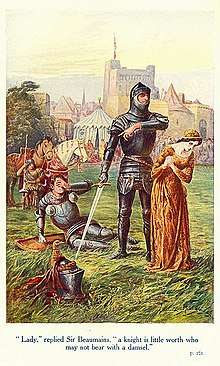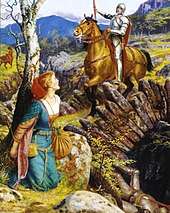Gareth
Sir Gareth (Welsh: [ˈɡarɛθ]; Old French: Guerrehet) is a Knight of the Round Table in Arthurian legend, nicknamed "Beaumains" in Le Morte d'Arthur. He was the youngest son of King Lot and Morgause, King Arthur's half-sister, thus making him Arthur's nephew, as well as brother to Gawain, Agravain, and Gaheris, and either a brother or half-brother of Mordred.[note 1]
| Gareth | |
|---|---|
| Matter of Britain character | |
 Howard Pyle's illustration for The Story of Sir Launcelot and His Companions (1907) | |
| First appearance | The First Continuation of Perceval, the Story of the Grail |
| In-universe information | |
| Title | Prince, Sir |
| Occupation | Knight of the Round Table |
| Family | |
| Spouse | Lyonesse |
| Origin | Orkney and/or Lothian |
Arthurian legend
In French literature
Gareth, as Guerrehet,[3] first appears in the First Continuation of Chrétien de Troyes's Perceval ou le Conte du Graal, where he is the protagonist of the final episode as he avenges the death of a fairy king named Brangemuer, son of Guingamuer, by slaying the giant known as "Little Knight". Several of his adventures are narrated in the Vulgate Cycle (Lancelot-Grail). In the Vulgate Merlin, Gareth and his brothers defect from their father King Lot and take service with King Arthur, participating in the early battles against the Saxon invaders of Britain and in the war against the Frankish king Claudas on the continent. As the youngest and often most chivalrous of the Orkney princes, Gareth later prevents his brothers Gawain and Agravain from killing their other sibling Gaheris in revenge for the murder of their mother Morgause, condemns his brothers for their killing of Lamorak, and attempts to dissuade Agravain and Mordred from exposing Lancelot and Guinevere's affair.
His death at the hands of Bors during Lancelot's rescue of Guinevere from being burned at the stake is related in the Mort Artu (Death of Arthur), the final volume of the Vulgate Cycle.[4] The Lancelot and the Mort Artu sections differ in their characterisation of Gareth: in the Lancelot, he is portrayed as Gawain's most cherished brother; in the Mort Artu, it is rather his older brother, Gaheris.[5]
Le Morte d'Arthur

Gareth is the subject of Book IV (Caxton VII) in Sir Thomas Malory's Le Morte d'Arthur, "The Tale of Sir Gareth of Orkney", which tells how he became a knight. In Malory's retelling of an episode from the Prose Tristan, Gareth seeks to prove himself worthy of knighthood through his deeds instead of just his lineage. For this reason, he arrives at Camelot in disguise as a kitchen boy as le bel inconnu, or the Fair Unknown, who comes without a name and therefore without a past. He is set to work by Sir Kay, who always gives him difficult work, teases him as a lowly kitchen boy and nicknames him "Beaumains" or "Good Hands" (alternatively "Beautiful Hands" or "Fair Hands"). Gareth receives much better attention from Sir Lancelot, who gives him gifts of clothes and gold for spending money.

Gareth then goes to the aid of an unknown woman, later revealed to be the Dame Lynette, to save her sister Lyonesse (both also appearing under various alternate spellings) from the Red Knight of the Red Lands. He is accompanied by the dwarf Melot, who knows his true identity. However, Lynette takes Gareth as a mere kitchen boy and constantly derides him. On the way, he slays the impressive Sir Perarde, the Black Knight, and takes his armour and horse. He then meets Sir Pertolope, the Green Knight, who mistakes him for his brother, the Black Knight. Lynette tells the Green Knight that he is a kitchen boy and begs him to rid her of him. Gareth overcomes the Green Knight, but spares his life in return for the knight's swearing to serve King Arthur. He then in much the same fashion defeats Sir Perymones, the Puce Knight (sometimes the Red Knight, but not to be confused with the one of the Red Lands), and Sir Persaunte (Persant of Inde), the Indigo Knight, both of whom also swear loyalty to Arthur. He arrives at Lyonesse's castle, where she is besieged by Sir Ironside, the Red Knight of the Red Lands. He fights him all day and finally prevails, although the Red Knight has the strength of seven men. He intends to kill him as he himself had slaughtered all the other knights who came to save the lady Lyonesse, but the Red Knight explains that he did so because the lady he loved made him swear to kill Lancelot, and the only way to get his attention was to kill the knights. Gareth spares him, making him swear to serve Arthur and also go to Camelot and apologise to Lancelot. Lustily in love with Lyonesse, Gareth conspires to consummate their relationship before marrying. Only by the magical intervention of Lynette is their tryst unsuccessful, thus preserving Gareth's virginity and, presumably, his standing with God. Gareth later counsels Lyonesse to report to King Arthur and pretend she does not know where he is; instead, he tells her to announce a tournament of his knights against the Round Table. This allows Gareth to disguise himself and win honour by defeating his brother knights. The heralds eventually acknowledge that he is Sir Gareth right as he strikes down Sir Gawain, his brother.[6]
In Book IV, there are only two knights that have ever successfully held against Lancelot: Sir Tristan and Gareth. This was always under conditions where one or both parties were unknown by the other, for these knights loved each other "passingly well". Gareth was knighted by Lancelot himself when he took upon him the adventure on behalf of Lynette. However, in Book VIII: "The Death of Arthur", the unarmed Gareth and his brother Gaheris are killed accidentally by Lancelot during the rescue of Guinevere. This leads to the final tragedy of Arthur's Round Table; Gawain refuses to allow King Arthur to accept Lancelot's sincere apology for the deaths of his two brothers. Lancelot genuinely mourns the death of Gareth, whom he loved closely like a son or younger brother. King Arthur is forced by Gawain and Mordred's insistence to go to war against Lancelot. Mordred's grief is largely faked, driven by his desire to become king. This leads to the splitting of the Round Table, Mordred's treachery in trying to seize Guinevere and the throne, Gawain's death from an old unhealed wound, and finally, Arthur and Mordred slaying each other in the final battle.
Modern versions
The legend of Gareth and Lynette has been reinterpreted by many writers and poets, the most renowned being Alfred Lord Tennyson in Idylls of the King (1859–1888). In this version the "colored" knights are replaced by knights associated with various times of day: the final knight is known as Night or Death and is the most feared of the three, though ultimately the weakest. Gareth marries Lynette.
In some other versions, Gareth marries Lynette's sister, whom he rescues, and Gaheris marries Lynette. Theodore Goodridge Roberts authored the short story "For to Achieve Your Adventure", in which Lynette knows she is sending Gareth into an ambush in an attempt to make him give up for his own protection.
- In the film Knights of the Round Table (1953), he was played by Anthony Forwood.
- Richard Thorp played him in the British film Lancelot and Guinevere (1963).
- Vera Chapman's novel The King's Damosel (1976) gives a complete version of Lynette's life.
- Gareth was portrayed by Jonathan Cake in the film First Knight (1995).
- In the novel Queen of Camelot (2002) by Nancy McKenzie, Gareth and Lynette formal became betrothed when he first came to Arthur.
- In the mobile game Fate Grand Order, Gareth is depicted as a female knight, while keeping much of the legend's original family traits and story.
Notes
- An enumeration of the four brothers (excluding Mordred) can be found in Chrétien de Troyes's Perceval, the Story of the Grail when Gawain tells the "white-haired queen" (his grandmother Igraine) the names of the four brothers ("Gawain is the oldest, the second Agravain the Proud [...], Gaheriet and Guerehet are the names of the following two."[1] A brief portrait of the five brothers (including Mordred) can be found in the prose Lancelot.[2]
References
- Verses 8139–8142 in the Dufournet edition; verses 8056–8060 in the Méla edition.
- Norris J. Lacy, ed., Lancelot-Grail: Lancelot Parts III and IV, Volume 4 of Lancelot-Grail: The Old French Arthurian Vulgate and Post-Vulgate in Translation, Boydell & Brewer Ltd, 2010, pp. 392–4. ISBN 9781843842354.
- Dentzien, Nicole (2004). The Openess of Myth: The Arthurian Tradition in the Middle Ages and Today. Königshausen & Neumann. ISBN 9783826028113.
- Norris J. Lacy, ed. and trans., Lancelot-Grail: The Death of Arthur, Volume 7 of Lancelot-Grail: The Old French Arthurian Vulgate and Post-Vulgate in Translation, Boydell & Brewer Ltd, 2010, p. 69. ISBN 9780859917704.
- Norris J. Lacy, ed., Lancelot-Grail: Lancelot Parts III and IV, pp. 393–4.
- "Sir Gareth". Archived from the original on 5 October 2011. Retrieved 27 June 2011.
External links
| Wikimedia Commons has media related to Gareth Beaumains. |
- Gareth and Lynette at the Camelot Project